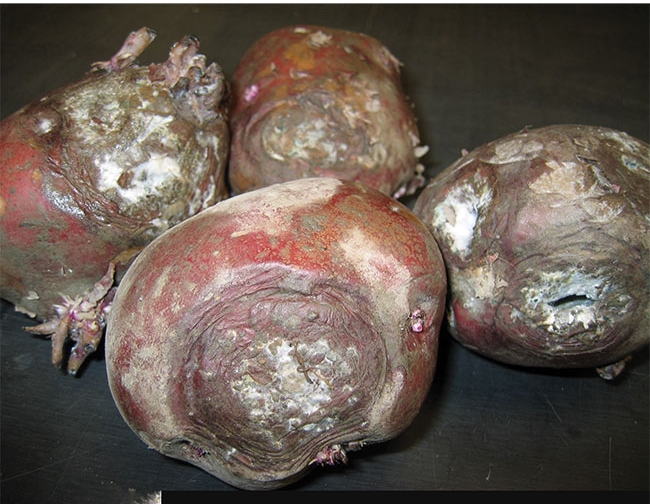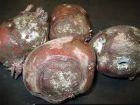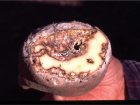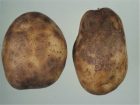
Features
Agronomy
Diseases
Scouting post-harvest diseases
Scouting and monitoring help reduce yield and quality losses and can save time and money. Diseases can manifest during the growing season, or at and after harvest, therefore scouting and monitoring can help identify diseases early in the cropping or storage cycle when it may still be possible to slow down or stop their spread. Regular scouting and monitoring of potato crops throughout the growing season and during storage are essential to good integrated pest management (IPM) programs.
January 2, 2019 By Donna Fleury
 Predicting and minimizing post-harvest diseases in storage.
Predicting and minimizing post-harvest diseases in storage.“For predicting potential post-harvest issues, there are two main strategies,” explains Ron Howard, plant pathologist with RJH Ag Research Solutions Ltd. in Brooks, Alta. “The first strategy is to determine what diseases were present in the crop during the growing season. Some post-harvest diseases often get their beginnings during the growing season, such as blackleg and various soft rots or dry rot. Other diseases such as late blight can infect both foliage and the tubers, increasing the risk of problems in storage. It is important to become familiar with the common potato diseases in an area, both in the field and storage. The second strategy is scouting the crop at harvest particularly when the potatoes are being dug, hauled in from the field and graded as they are loaded into storage.”
Grading out infected and mechanically damaged tubers and assessing the culls removed prior to storage can provide a good indication of potential disease risks and problems. If disease risk is high, such as with Fusarium dry rot on bruised tubers, then growers will want to take preventative steps such as applying post-harvest fungicides as potatoes are going into storage. Avoiding unnecessary mechanical injury during handling operations is a priority. Once the potatoes are in storage, monitoring and controlling any disease issues quickly is important, as is keeping storage temperatures as low as possible for the type of potato being stored.
“For some diseases, such as bacterial soft rot, increasing the air flow through the pile can help,” Howard says. “Applying registered products such as hydrogen peroxide (StorOx), which is usually fogged into potato piles in storage, can also help arrest some bacterial and fungal diseases at early stages. Increasing ventilation to cool down tubers and slow down diseases can also be helpful. However, if larger pockets of rot begin to develop in a pile, then heavy culling may be the best strategy, with the good healthy potatoes delivered to a processor and the culls either delivered to a feedlot for example or spread on a field and worked in the following spring. As winter proceeds, continue monitoring the bins and piles in storage and any potatoes that are suspect should be moved out as quickly as possible.”
Monitoring potatoes in storage is done in two main ways, both which should be done regularly. There are various electronic monitoring control systems that have sensors in various locations in the storage facility. This information helps keep temperature and humidity and other conditions optimal in the facility. “Monitoring storage in person is probably the most important, and just like crop scouting and monitoring during the growing season, storage facilities should be scouted at least once a week or monitored more frequently if there is a localized outbreak of a disease,” Howard adds. “Check existing problems for increased incidence or severity, and assess the effectiveness of any control measures implemented. Check instrumentation and computer monitoring systems regularly, along with visual inspection and ‘smelling the air’ for odors of rotting potatoes.”
Some storage rots are very pungent, for example bacterial soft rot can usually be identified by smell, and there may be seepage from rotting potatoes into corridors and plenums. Walking through the storage facility, checking high-risk areas and monitoring storage walkways and catwalks to look for indications of hotspots or signs of potatoes starting to decay. For example, potatoes infected with Fusarium will have a whitish tinge on the surface of the potatoes (“bloaters”); hotspots will usually form condensation on the roof of the storage facility or have water coming off the pile. If a pile has settled or specific areas in a bin have sunk substantially, then that usually indicates a problem underneath.
Howard emphasizes that record keeping is very important and keeping careful records of each inspection is recommended. Inspection records should include location, symptoms and signs of diseases, date and make sure to take photos and collect samples if needed. Enter observations on record forms (written), spreadsheets or electronic data forms (tablet, laptop, iPhone), or a portable voice recorder. Custom software is available to keep written and photographic records throughout a crop cycle, to generate reports and to send information to others such as crop consultants or diagnosticians. Self-use diagnostic kits are available for many bacterial, fungal and viral diseases. However, diagnosis can be challenging, so don’t be afraid to seek professional help from plant health labs, specialists and crop consultants. There can often be many factors at play, so be sure to take a ‘big picture’ view of the situations.
“Predicting and minimizing post-harvest diseases in storage requires scouting and monitoring the health of the crop from the time the seed arrives on the farm, through the growing season to harvest and throughout post-harvest storage,” Howard explains. “Developing a scouting plan that matches the type of potatoes you’re growing, potential diseases that may be present, and the production system in use before the season begins, is critical. Implementing best practices from the selection of high quality disease-free seed potatoes to cultural practices and pest management programs followed throughout the growing season can help minimize the risk of post-harvest diseases during storage until delivery to processors and other buyers.”
Print this page


